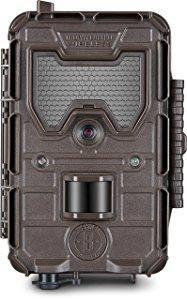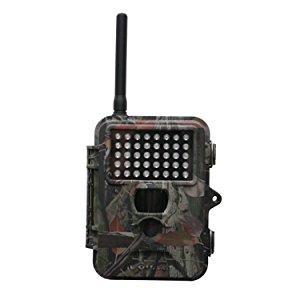To understand how a wireless trail camera or a cellular trail camera can help you get the results you want, you’ll need to understand how they differ. There are some similarities, and as you shop for the right equipment you may even see a few units included in both categories. The terms don’t mean the same thing. It’s that simple.
A wireless camera is one that works on a Wi-Fi signal. It sends images through that connection. A cellular camera can send images to a phone, using a network to connect by email or text. For the hunter seeking to send images anytime, from anywhere, it would be best to invest in a cellular-capable camera.
Look closely at descriptions from some manufacturers and you’ll see wireless simply means you don’t have to go to the camera site. You need to be within range of the Wi-Fi signal. This does have advantages, obviously. Many hunters find a cellular camera to be the best choice, but it depends on a number of factors, including the amount you’ll have to invest.
For those who aren’t electronic/camera fanatics, the number of configurations can be confusing. Some trail cameras are great for pictures and videos, some do only one or the other. There are a number of options when it comes to flash as well – low-glow infrared, red-glow, white LED, incandescent. You can also get a no-glow infrared, which is not visible.

Wireless vs. Cellular Trail Camera: Which is Better?
Perhaps the best way to answer this question, if it can be answered, is to look closely at each type. It is especially important to pay attention to details of the features and benefits, as presented by the manufacturers. It’s also essential to understand that, as you’re shopping, you’ll see “wireless” and “cellular” used interchangeably.
Keep in mind, as you look at cellular trail cameras, that your new camera doesn’t have to operate on the same network as your current cell phone. But it’s always best to ask questions and clear up any doubts when you start using new equipment. Trail cameras using this new technology can be rather easy to use, though some units require configuration. If you buy one of the more complex cameras, you may have to learn a bit about the technology to get the best use of your new purchase.
You’ll also find that prices vary widely, with some of the lower-priced cameras delivering features and benefits found in the more expensive units. It’s essential to look at how you can change settings. User-friendly is important when it comes to reducing stress during the use of these cameras.
With this information in hand, it’s time to separate the two types of cameras, so you can choose which one will work best for you. Both “wireless” and “cellular” cameras work without wire hook-up. But they do send photos in different ways. A wireless camera uses radio frequency or Wi-Fi network to send images to a paired application.
- Cellular cameras work as a type of cellular “phone” since they require the use of a cellular tower. This means you’ll need to pay a monthly fee to a provider of cellular service. You won’t have this fee with a true wireless camera, though you’ll have the usual Internet/Wi-Fi requirements.
- Wireless trail cameras are different from cellular trail cameras. While both do are wireless, they send images in different ways. A wireless camera works by radio frequencies and or a Wi-Fi network to send images to the applications they work with. A cellular camera is very similar to a cellular phone. They require the use of a cellular tower.
You will need to have a connection to a cellular system, so you will have to pay monthly to get access to a cellular provider. But, with a wireless trail camera, you will not need to have monthly cellular access. It’s difficult to say which is better, because it really comes down to personal preference for the way you receive information.
Top 4 Best Wireless & Cellular Trail Camera Reviews 2017
1. Covert Special Ops Code Black – Best for Large Detection Area

Speed is also a major benefit with the Covert Special Ops Code Black camera. You’ll be able to see the image on your phone or in email within 60 seconds.
Trigger speed is 1.2 seconds, which is in the average range. If you use the camera out of cell mode, you’ll have a recovery time of about six seconds.
Don’t worry too much about the difference between quality of day images and night images. Both are more than acceptable, with night images captured by invisible-flash LEDs. This flash technology is invisible to the naked eye, yet produces clear images.
The best features of this camera are the large detection area and the flash technology. Trigger speed is a bit slower than some in this category.
2. Bushnell Trophy Cam Wireless Trail Camera – Best for Weather Conditions and Operation Modes

Use a few basic words to describe the Bushnell Trophy Cam HD Wireless: easy to set up; quick access to settings; manage the camera by computer or smart phone. Objects are detected up to 60 feet away with the sensitive motion detector and the trigger speed of just above half a second.
This unit also has a temperature sensor that helps it function in tough weather conditions. The no-glow flash with 32 infrared LEDs provides sharp, clear images in the dark. Choose from live-trigger mode, time lapse or multi-flash mode. New version has 14MP. You’ll like the three operation modes, the trigger speed and the temperature sensor. It’s now available with 14 MP lens, without increase in price.
3. Spartan HD GoCam – Best for Warranty

It’s offered with a no-contract, pay-as-you-go plan. Easy to use, the Spartan HD GoCam runs on 12 AA batteries. Trigger speed is less than one second, and the infrared LED flash lights up the area to 70 or a bit beyond.
Photo resolution can be set up to 8 MP, or the camera can be used for video. Two settings allow different trigger and time-lapse choices. The Spartan is also protected from the elements with flush-case front and rear and a strong rubber gasket on the front case.
Two-year warranty, one of the best in the industry. The best benefit with this unit is the two-year warranty. It also delvers great trigger speed.
4. HCO Uway GSM Wireless Scouting Camera – Best for Affordability

Using the AT&T wireless prepaid card, you can capture high-resolution wildlife images and save them to an SD card. Smaller images can be sent by email or text picture. Allow two minutes for receipt of the image, but forward it to up to four phone or email accounts.
Picture quality is very good, at 5 MP. It does have a visible flash, not a no-glow flash triggered by motion. You’ll have about three weeks or a bit more of operation with 12 lithium batteries, but it comes with an external battery jack so you can use solar power.
Trigger speed is 1.2 seconds. This is a relatively inexpensive camera, with average trigger speed and visible flash.
Conclusion
Wireless connectivity and cellular operation can be a great benefit, if you are able to set it up in a reasonable amount of time and start using the equipment you’ve invested in. As you shop for the right camera, it’s necessary to make some decision such as: pay-as-you-go or season plan? You may also want to look into a signal booster to cover more area. You may also want to consider a camera with solar-panel capability, so you aren’t worrying about batteries all the time.
Some cameras transmit on their own (wireless) or use a SIM card from a cellular carrier. When it comes to determining which camera is “best,” it’s really comparing the proverbial apples to oranges. A wireless camera may not send pictures to your cell phone. A cellular camera will. In the final decision, make sure you go with what works for you, and get the camera that will hold up on the trail.
Most of the newer cameras are very user-friendly and convenient to set up in the field. If you would like to establish something like a security system around your property, these can also be excellent for this purpose. Delays for viewing are general 90 seconds or less, making the wireless/cellular camera an excellent tool on the trail.

